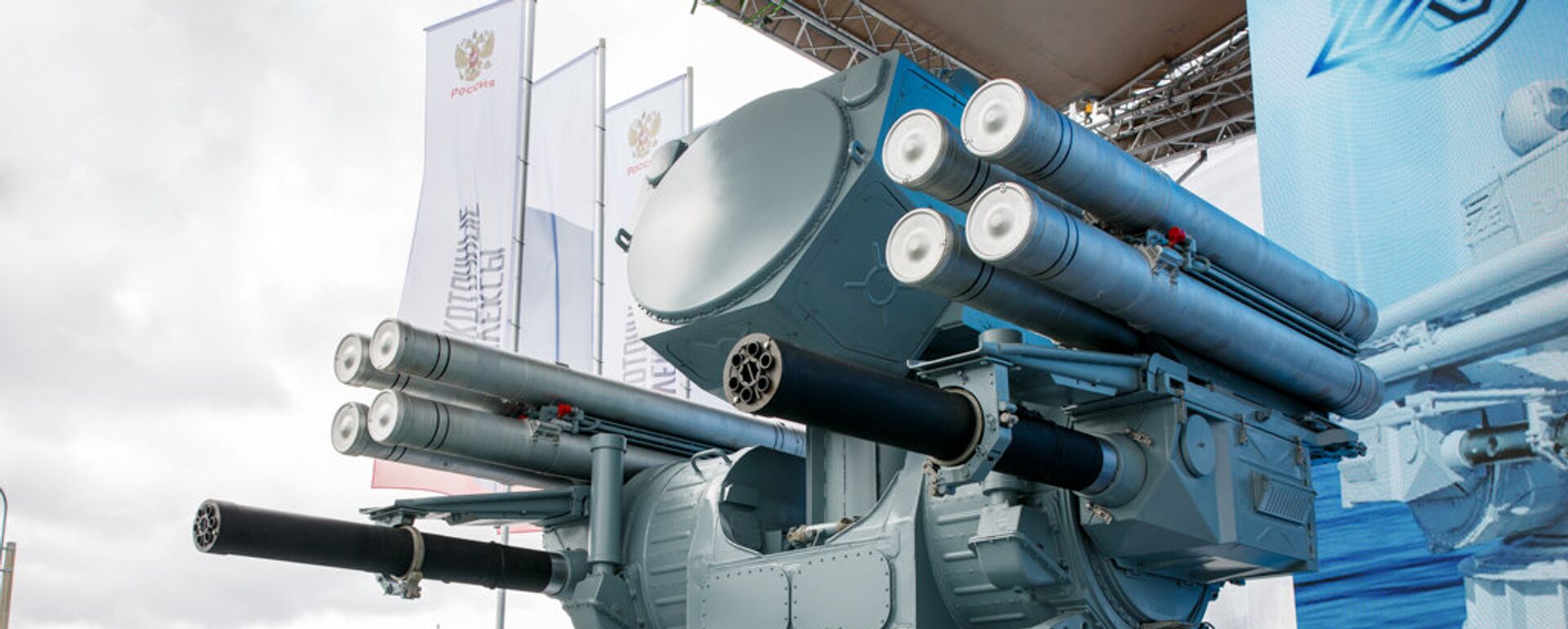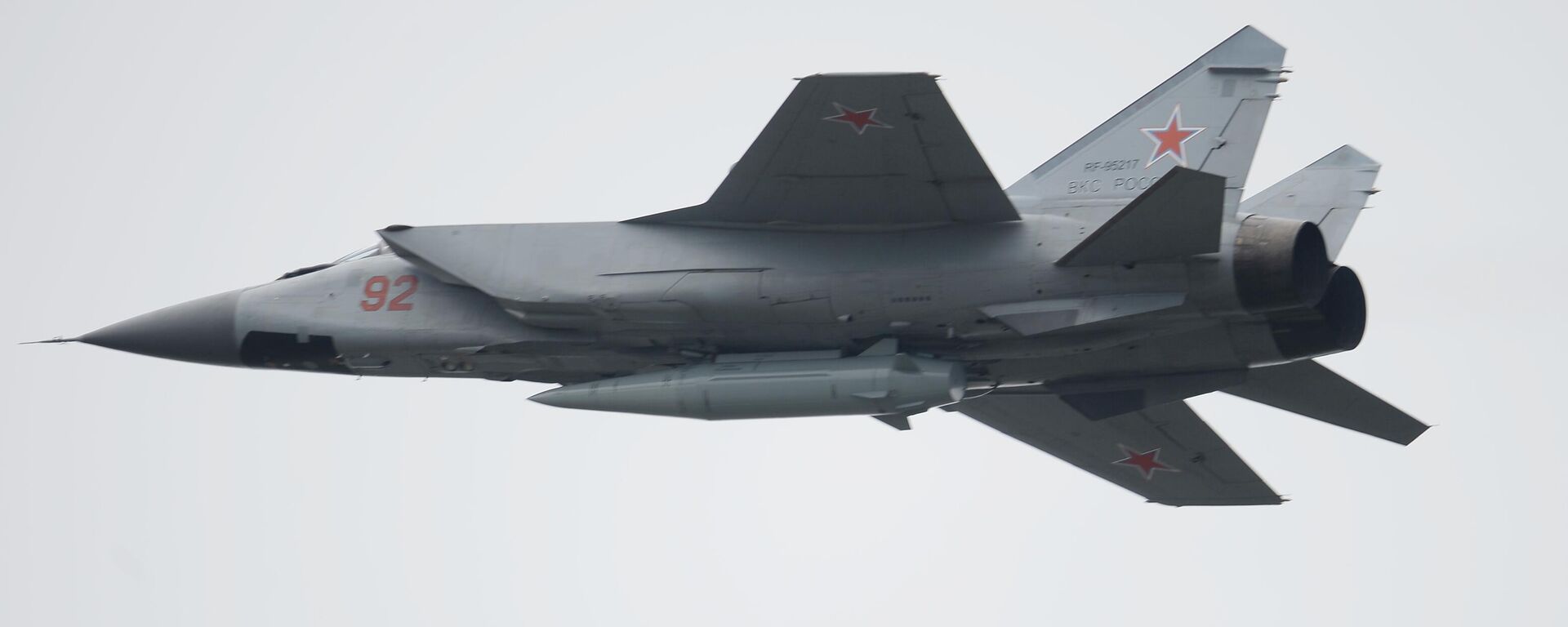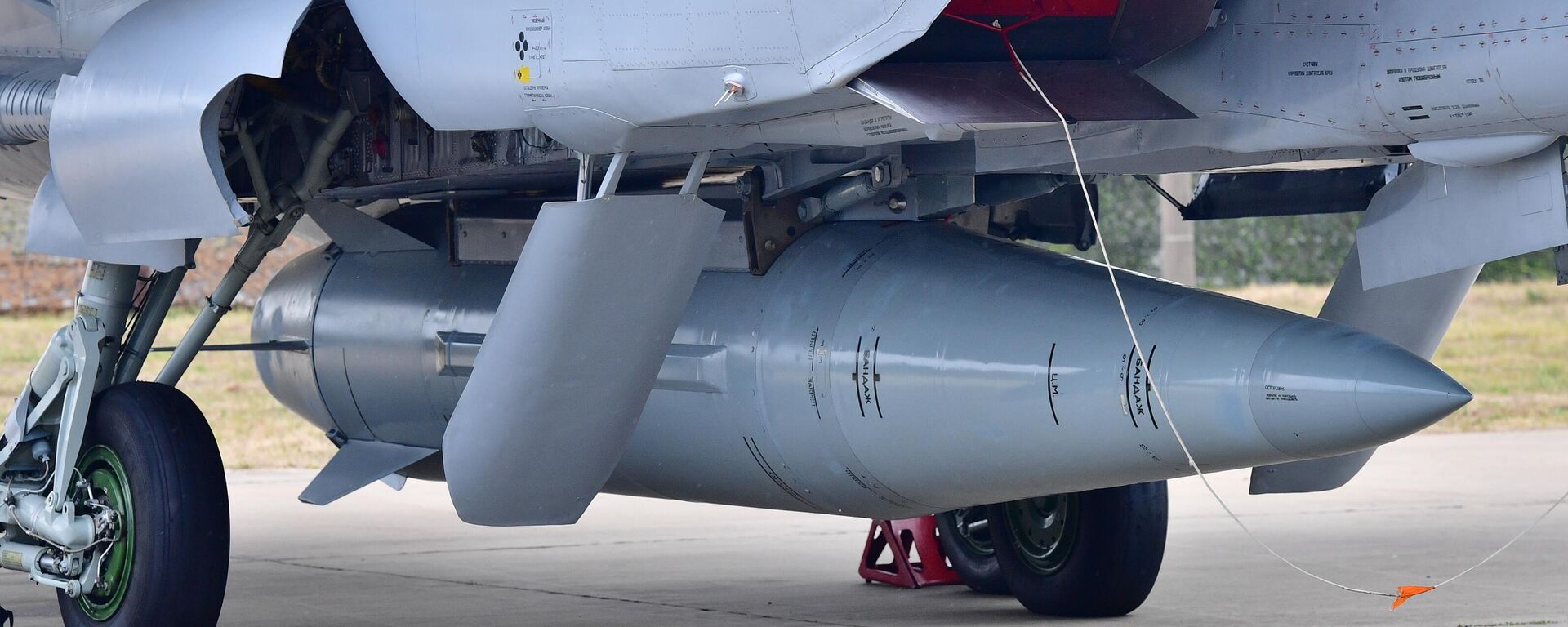https://sputnikglobe.com/20231020/is-russias-kinzhal-missile-nuclear-capable-1114335350.html
Is Russia's Kinzhal Missile Nuclear Capable?
Is Russia's Kinzhal Missile Nuclear Capable?
Sputnik International
The Kinzhal missile, first disclosed by Russia in 2018, signifies a monumental stride in hypersonic weaponry. However, this weapon system has been subjected to expert divergent opinions. This article gives insights into its nuclear capabilities and debunks untruths about claims of its downing during combat operations.
2023-10-20T14:44+0000
2023-10-20T14:44+0000
2023-10-20T14:50+0000
military
military & intelligence
vladimir putin
igor konashenkov
ukraine
vladimir
russia
russian ministry of defense
russian aerospace forces
russian defense ministry
https://cdn1.img.sputnikglobe.com/img/07e6/02/07/1092823895_0:0:2843:1599_1920x0_80_0_0_810525b39933843a2e9f32624cdd3fc6.jpg
Russia developed the Kinzhal missile according to its defense necessities to bolster its military potential after the US withdrawal from the Antiballistic Missile (ABM) Treaty 21 years ago. Although the missile production attracted praise from some experts, it has drawn criticism from Western media.What is true about the Kinzhal missile? What is not, and is it nuclear capable? Sputnik explains.What is Kinzhal Missile?In March 2018, Russian President Vladimir Putin showcased a line-up of six state-of-the-art weapons, including the Kh-47M2 "Kinzhal" (lit. Dagger) missile. This weapon is air-launched, and hypersonic.With the Kinzhal system, a short-range solid-fuel missile is integrated with a modified MiG-31K interceptor jet, creating a potent medium-range strike capability.The Kinzhal hypersonic system employs a MiG-31K jet to transport the missile to altitudes of roughly 18km (59,000 feet) while flying at supersonic speeds.Once released, the missile descends approximately 100 feet, shedding a protective cap that shields its rocket engine during jet flight. It then engages its solid rocket motors to reach hypersonic speeds. The Kinzhal missile is astonishingly fast, clocking in at speeds of up to Mach 10, or approximately 12,350 kilometers per hour.Technical Specifications of KinzhalMilitary Objective of Kinzhal MissileRussia's stated intention for the development of the Kinzhal missile is to disable missile defense systems. This aim matches the technical abilities of the designated modified carrier jets. However, the Kinzhal missile system could also target significant assets like carrier groups.This weapon can be employed like a regular tool on the battlefield. For instance, it was used to target underground weapon stockpiles in Ukraine in the course of Russia's special military operation. Furthermore, these missiles can reach distant targets without entering the airspace of countries Russia considers adversaries. This is possible due to their extended range, allowing them to stay within their own or friendly airspace.Is it Possible to Down Kinzhal Missile?On 9 May 2023, a number of Ukrainian and Western media outlets circulated headlines asserting that US-supplied air defense systems had downed a Kinzhal missile, doubting the assertion of the near impossibility of intercepting the missile owing to its high velocity. However, on 11 May 2023, the spurious allegations were dumped into the bins of incognizance by the official representative of the Russian Ministry of Defense, Lieutenant General Igor Konashenkov.On May 16, 2023, some Western news outlets debunked the claims regarding the shooting down of the Kinzhals, stating that it happened "quickly." They argued that the unsubstantiated allegation did not specify whether the supposed interception of the Russian missile was carried out by the American-supplied Patriot air defense system. However, they reported that the Patriot air defense system was damaged, according to US officials. Also, video footage released by the Russian Defense Ministry showed when the American air defense system exploded.Honored Russian military pilot Vladimir Popov also corroborated the report of the Russian Defense Ministry spokesman's report when he told news sources, “The Ukrainian authorities, of course, need to raise the morale of their people somehow. Theoretically, there is only one way to shoot down the Kinzhal: if you fire all the air defense missiles in one gulp, en masse, knowing that the hypersonic projectile is coming in exactly this direction.”Moreover, a spokesman for the Ukrainian Armed Forces Air Force, Yuriy Ignat, refuted the news of a downed Russian Kinzhal missile. “I have already refuted [this data] a thousand times. There was a possibility of use, but no ballistic missiles were detected. What some chairmen of military administrations say there is what they have already received for it.” Kinzhal Missile Combat DeploymentOn March 18, 2022, Russia used the Kinzhal hypersonic missile system in a military operation in Ukraine. They targeted a Ukrainian underground depot near Delyatin in the Ivano-Frankovsk region. According to the Russian Defense Ministry, the missile was launched from a distance of over 1,000 km and reached its target in less than 10 minutes. The missile's hypersonic speed and high kinetic energy allowed it to destroy the sheltered underground arsenal in a jagged landscape.On March 20, 2022, one of these missiles hit a large base for storing fuel and lubricants for Ukrainian troops in the Konstantinovka area. On May 9 and August 7, 2022, Kinzhal missiles were used against military targets in the Odessa and Vinnitsa regions, respectively.The Russian Ministry of Defense revealed on March 9, 2023 that a substantial counterstrike was launched in retaliation for Kiev's attacks on the Bryansk region of Russia. The Kinzhal complex targeted a communications center near Lvov located 120 meters below the surface.In September 2023, reports appeared that an Su-34 fighter aircraft had first used a Kinzhal hypersonic missile in the ongoing Ukrainian conflict, and its crew was nominated for awards for professionalism.From October 2023, Russian fighters armed with Kinzhal missiles are set to begin monitoring the Black Sea's airspace. Vladimir Putin stated this during his recent official visit to China:
https://sputnikglobe.com/20230919/russia-celebrates-gunsmith-day-with-record-missile-production-1113492974.html
https://sputnikglobe.com/20230517/unstoppable-kinzhal-one-us-made-patriot-cracked-up-more-to-come-1110424287.html
https://sputnikglobe.com/20230904/sky-high-showdown-su-34-deployed-hypersonic-kinzhal-dagger-missile-1113101815.html
ukraine
vladimir
russia
Sputnik International
feedback@sputniknews.com
+74956456601
MIA „Rosiya Segodnya“
2023
Chimauchem Nwosu
https://cdn1.img.sputnikglobe.com/img/07e7/09/01/1113046371_0:99:1536:1635_100x100_80_0_0_9c5c627283eca931c39fe4852bbb301c.jpg
Chimauchem Nwosu
https://cdn1.img.sputnikglobe.com/img/07e7/09/01/1113046371_0:99:1536:1635_100x100_80_0_0_9c5c627283eca931c39fe4852bbb301c.jpg
News
en_EN
Sputnik International
feedback@sputniknews.com
+74956456601
MIA „Rosiya Segodnya“
Sputnik International
feedback@sputniknews.com
+74956456601
MIA „Rosiya Segodnya“
Chimauchem Nwosu
https://cdn1.img.sputnikglobe.com/img/07e7/09/01/1113046371_0:99:1536:1635_100x100_80_0_0_9c5c627283eca931c39fe4852bbb301c.jpg
kinzhal missile, kinzhal, kh-47m2, dagger missile, hypersonic missile, nuclear warheads, russian military, air-launched ballistic missile, mig-31k, tu-160, tu-22m3m, hypersonic speed, mach 10, nuclear capabilities, missile defense systems, global defense strategies, military technology, vladimir putin, federal assembly, military objectives, national security, underground weapon stockpiles, ukraine, russian ministry of defense, lieutenant general igor konashenkov, vladimir popov, yuriy ignat, combat deployment, russian defense ministry, ivano-frankovsk region, konstantinovka region, odessa region, vinnytsia region, bryansk region, lvov, black sea airspace, russian aerospace forces, mach 9.
kinzhal missile, kinzhal, kh-47m2, dagger missile, hypersonic missile, nuclear warheads, russian military, air-launched ballistic missile, mig-31k, tu-160, tu-22m3m, hypersonic speed, mach 10, nuclear capabilities, missile defense systems, global defense strategies, military technology, vladimir putin, federal assembly, military objectives, national security, underground weapon stockpiles, ukraine, russian ministry of defense, lieutenant general igor konashenkov, vladimir popov, yuriy ignat, combat deployment, russian defense ministry, ivano-frankovsk region, konstantinovka region, odessa region, vinnytsia region, bryansk region, lvov, black sea airspace, russian aerospace forces, mach 9.
Is Russia's Kinzhal Missile Nuclear Capable?
14:44 GMT 20.10.2023 (Updated: 14:50 GMT 20.10.2023) The Kinzhal missile, first unveiled by Russia in 2018 during a speech by President Vladimir Putin, has sparked a wide range of expert opinions about its capabilities in combat operations. This article aims to debunk misconceptions about this modern weapon and highlight its features.
Russia developed the
Kinzhal missile according to its defense necessities to bolster its military potential after the US withdrawal from the Antiballistic Missile (ABM) Treaty 21 years ago. Although the missile production attracted praise from some experts, it has drawn criticism from Western media.
What is true about the Kinzhal missile? What is not, and is it nuclear capable? Sputnik explains.
In March 2018, Russian President Vladimir Putin showcased a line-up of six state-of-the-art weapons, including the Kh-47M2 "Kinzhal" (lit. Dagger) missile. This weapon is air-launched, and hypersonic.
With the Kinzhal system, a short-range solid-fuel missile is integrated with a modified MiG-31K interceptor jet, creating a potent medium-range strike capability.
“The missile flying at a hypersonic speed, 10 times faster than the speed of sound, can also maneuver at all phases of its flight trajectory, which also allows it to overcome all existing and, I think, prospective anti-aircraft and anti-missile defense systems, delivering nuclear and conventional warheads in a range of over 2,000 kilometers,” Putin said.
The Kinzhal hypersonic system employs a MiG-31K jet to transport the missile to altitudes of roughly 18km (59,000 feet) while flying at supersonic speeds.
Once released, the missile descends approximately 100 feet, shedding a protective cap that shields its rocket engine during jet flight. It then engages its solid rocket motors to reach hypersonic speeds. The Kinzhal missile is astonishingly fast, clocking in at speeds of up to Mach 10, or approximately 12,350 kilometers per hour.
Kinzhal is equipped to carry regular or nuclear warheads, with a maximum payload of 480 kilograms. It also has a thermonuclear option featuring a warhead ranging from 10 to 50 kilotons.
Technical Specifications of Kinzhal
Missile type: air-launched ballistic missile
Circular probable deviation (CPD) – 1 meter
Weight: 4,300 kg ( 9,500 lb )
Length: 23 ft 7 in ( 7.2 m )
Diameter: 47 in ( 1200 mm )
Wingspan: 5 ft 3 in ( 1.6 m )
Type of warhead: penetrating high-explosive, conventional high explosive, or a low-yield nuclear warhead
Steering system: 4 cropped delta-fins
Damage radius: from 15,000 square meters (data classified)
Guidance: GLONASS with an optical homing head, as well as an AWACS aviation complex on a carrier.
Nuclear yield: 10-50 kilotons
Carriers: Su-57, MiG-31K , Tu-160, Tu-22M3M
Damage range: 2000 km (MiG-31K), 3,000 km (Tu-22M3)
Maximum speed: hypersonic up to 14,688 km/h (Mach 10-12)
Flight time: about 10 minutes per 1000 km
Flight altitude: up to 18 km
Engine: solid fuel, dual-mode launch, and propulsion

19 September 2023, 14:54 GMT
Military Objective of Kinzhal Missile
Russia's stated intention for the development of the Kinzhal missile is to disable missile defense systems. This aim matches the technical abilities of the designated modified carrier jets. However, the Kinzhal missile system could also target significant assets like carrier groups.
This weapon can be employed like a regular tool on the battlefield. For instance, it was used to target underground weapon stockpiles in Ukraine in the course of Russia's special military operation. Furthermore, these missiles can reach distant targets without entering the airspace of countries Russia considers adversaries. This is possible due to their extended range, allowing them to stay within their own or friendly airspace.
Is it Possible to Down Kinzhal Missile?
On 9 May 2023, a number of Ukrainian and Western media outlets circulated headlines asserting that US-supplied air defense systems had
downed a Kinzhal missile, doubting the assertion of the near impossibility of intercepting the missile owing to its high velocity.
However, on 11 May 2023, the spurious allegations were
dumped into the bins of incognizance by the official representative of the Russian Ministry of Defense, Lieutenant General Igor Konashenkov.
“A US-made Patriot anti-aircraft missile system was hit by a high-precision strike from the Kinzhal hypersonic missile system in the city of Kiev,” he said.
On May 16, 2023, some Western news outlets debunked the claims regarding the shooting down of the Kinzhals, stating that it happened "quickly." They argued that the unsubstantiated allegation did not specify whether the supposed interception of the Russian missile was carried out by the American-supplied Patriot air defense system. However, they reported that the Patriot air defense system was damaged, according to US officials. Also, video footage released by the Russian Defense Ministry showed when the American air defense system exploded.
Honored Russian military pilot Vladimir Popov also
corroborated the report of the Russian Defense Ministry spokesman's report when he told news sources,
“The Ukrainian authorities, of course, need to raise the morale of their people somehow. Theoretically, there is only one way to shoot down the Kinzhal: if you fire all the air defense missiles in one gulp, en masse, knowing that the hypersonic projectile is coming in exactly this direction.”Moreover, a spokesman for the Ukrainian Armed Forces Air Force, Yuriy Ignat,
refuted the news of a downed Russian Kinzhal missile.
“I have already refuted [this data] a thousand times. There was a possibility of use, but no ballistic missiles were detected. What some chairmen of military administrations say there is what they have already received for it.” Kinzhal Missile Combat Deployment
On March 18, 2022, Russia used the Kinzhal hypersonic missile system in a military operation in Ukraine. They targeted a Ukrainian underground depot near Delyatin in the Ivano-Frankovsk region. According to the Russian Defense Ministry, the missile was launched from a distance of over 1,000 km and reached its target in less than 10 minutes. The missile's hypersonic speed and high kinetic energy allowed it to destroy the sheltered underground arsenal in a jagged landscape.

4 September 2023, 13:03 GMT
On March 20, 2022, one of these missiles hit a large base for storing fuel and lubricants for Ukrainian troops in the Konstantinovka area. On May 9 and August 7, 2022, Kinzhal missiles were used against military targets in the Odessa and Vinnitsa regions, respectively.
The Russian Ministry of Defense revealed on March 9, 2023 that a substantial counterstrike was launched in retaliation for Kiev's attacks on the Bryansk region of Russia. The Kinzhal complex targeted a communications center near Lvov located 120 meters below the surface.
In September 2023, reports appeared that an
Su-34 fighter aircraft had first used a Kinzhal hypersonic missile in the ongoing Ukrainian conflict, and its crew was nominated for awards for professionalism.
From October 2023, Russian fighters armed with Kinzhal missiles are set to begin monitoring the Black Sea's airspace. Vladimir Putin stated this during his recent official visit to China:
“It’s not a threat what I’m going to say now. However, on my instructions, the Russian Aerospace Forces are beginning to patrol the airspace in the neutral zone over the Black Sea continuously. Our MiG-31 aircraft are armed with Kinzhal systems. They have a range of over 1,000 km at Mach 9.”








